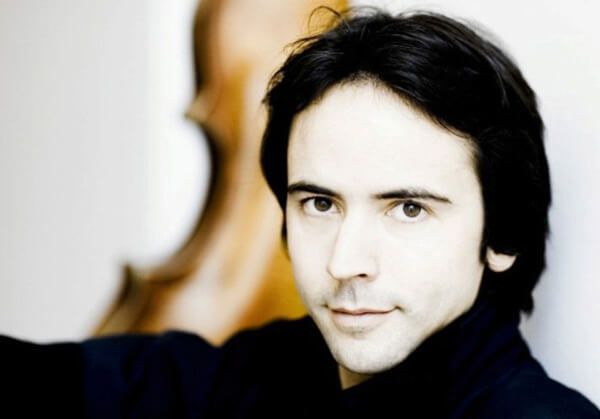 Jean-Guihen Queyras and Ensemble Resonanz lit up the Ij Haven last night in Amsterdam’s Muzikgebouw aan’t Ij. There was a twinkling view of the harbor through this great glass house, and the Ensemble matched this crystalline vision with a lush dynamic ebb and flow in the treatment of the four pieces programmed. With floors of naked cedarwood, red plush seats, blue light glowing through the latticed walls, and lighting and tech equipment exposed at the ceiling, the concert hall has the feel of Zankel (at Carnegie Hall, Ed.), but more spacious. Throughout the evening, the respect of the audience was astonishing; not a cough was to be heard until the general applause, so that diminuendos in the music and the space between movements enjoyed a profound and utter silence.
Jean-Guihen Queyras and Ensemble Resonanz lit up the Ij Haven last night in Amsterdam’s Muzikgebouw aan’t Ij. There was a twinkling view of the harbor through this great glass house, and the Ensemble matched this crystalline vision with a lush dynamic ebb and flow in the treatment of the four pieces programmed. With floors of naked cedarwood, red plush seats, blue light glowing through the latticed walls, and lighting and tech equipment exposed at the ceiling, the concert hall has the feel of Zankel (at Carnegie Hall, Ed.), but more spacious. Throughout the evening, the respect of the audience was astonishing; not a cough was to be heard until the general applause, so that diminuendos in the music and the space between movements enjoyed a profound and utter silence.

Jean-Guihen Queyras - Photo by Marco Borggreve
The Concerto in E-flat ‘Dumbarton Oaks’ (1938) is core to Stravinsky’s neo-classical output. Commissioned for a wedding anniversary and composed before the outbreak of World War II, it is a buoyant and sunny piece, intricate in orchestration, very much a 20th century nod to the Brandenburg concertos, it has always seemed to me. Movement 1, Tempo giusto brims with playful melodies, forward motion, and very individual statements on the flute, horn, bassoon and strings. The small chamber force (only ten strings) handled well these symphony-heavy melodies. The third movement, con moto, has some of the possessed ritual outbursts familiar from Le Sacre du Printemps. By the time this was written, film music was already coming into its own as an orchestral genre, and I believe we can hear a pictorial suggestiveness here, much more than in any of the abstract music which had dominated art music in the previous two decades. These ornate, driving musical churnings describe the complexity and fast pace of modern urban life. If Schoenberg emancipated the dissonance, Stravinsky in Dumbarton Oaks had revitalized the whole diatonic language. Chromatic events are well-disguised and introduced gently.
Schnittke’s Triosonate (1985) is a true hodgepodge of styles, but thematically unified in a mood of dread. Written for a larger consort of strings, it features disjunct, atonal violin melodies anchored by droning fifths in the lower strings. A more homophonic tutti in 6/8 emerges, setting up a very touching minor-mode cadential phrase. Atmospheric white noise is achieved with special bowing techniques. Before long, though, the Psycho-slashing tutti is back to plead with us manically. Schnittke’s music seems to be about the exposure of and confrontation with life’s stuggles. Important melodic themes are revisited after rumination; the 6/8 passage makes a final return, leading to more dark instrospection. Whereas Dumbarton Oaks gives a sense of a choir of voices, Triosonate is the soul-searching of a tortured individual consciousness. Consonant triads, bringing a brief respite to the sinister turns of phrase, eventually give way to the pervasive sense of dread. Ensemble Resonanz handled stark shifts in dynamics quite cleanly without a conductor, as Queyras had joined the cello section.

Ensemble Resonanz - Photo by Michael Haydn
Arvo Pärt’s Fratres (1977), or ‘brothers,’ maintains a very uniform texture throughout, with very static harmonic rhythm: a low drone supports an upper strings chorale. These chords float and pine for their never-quite-achieved resolution. Phrases are outlined by a refrain on the bass drum and clave – “doorklinkende Klank” according to the program. Although the ensemble had the unity of a great chamber group, the decay of these lamenting chords was like the dispersal of smoke, immeasurable and elusive.
Queyras paid his dues in the Ensemble InterContemporain and is known as a great Haydn specialist. Here, the classical master’s Celloconcert nr. 1 in C (ca. 1761-69) closed the concert, forming “classical” bookends (with the Stravinsky) to the more modern and idiosyncratic composers within. Queyras gave Haydn a chiaroscuro texture, switching deftly between dynamic extremes. The hall’s acoustics had nowhere for fortissimo notes to hide, so big gestures were arresting, and yet soft statements floated very lightly from the stage. The first movement cadenza shows Haydn to be harmonically adventurous for his time. The adagio takes the form of a stately procession. Anyone who doubts Haydn’s influence on Mozart should listen to this beautiful slow movement. The final movement, another sonata allegro, is bursting with an operatic urgency. The rhythmic precision required of this early Classical work was well-served by Ensemble Resonanz and the soloist, who made it seem a matter of spontaneous expression.
—
Rob Wendt is a pianist / composer / music educator living in Astoria, NY. You can follow him on twitter: @RobWendt





















